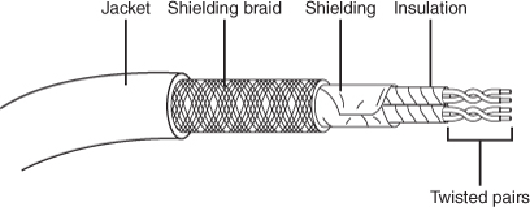Hardware Reference
In-Depth Information
Figure 17.8
An STP cable.
Shielded Versus Unshielded Twisted Pair
Whencablingwasbeingdevelopedforusewithcomputers,itwasfirstthoughtthatshielding
the cable from external interference was the best way to reduce interference and provide for
greater transmission speeds. However, it was discovered that twisting the pairs of wires is a
more effective way to prevent interference from disrupting transmissions. As a result, earlier
cablingscenariosreliedonshieldedcablesratherthantheunshieldedcablesmorecommonly
in use today.
Shielded cables also have some special grounding concerns because one, and only one, end
of a shielded cable should be connected to an earth ground; issues arose when people inad-
vertently caused grounding loops to occur by connecting both ends or caused the shield to
act as an antenna because it wasn't grounded.
Grounding loops
are created when two grounds are tied together. This is a bad situation be-
cause each ground can have a slightly different potential, resulting in a circuit that has low
voltage but infinite amperage. This causes undue stress on electrical components and can be
a fire hazard.
Most Ethernet installations that use twisted-pair cabling use UTP because the physical
flexibility and small size of the cable and connectors makes routing it easy. However, its
lackofelectricalinsulationcanmakeinterferencefromfluorescentlighting,elevators,and
alarm systems (among other devices) a major problem. If you use UTP in installations






